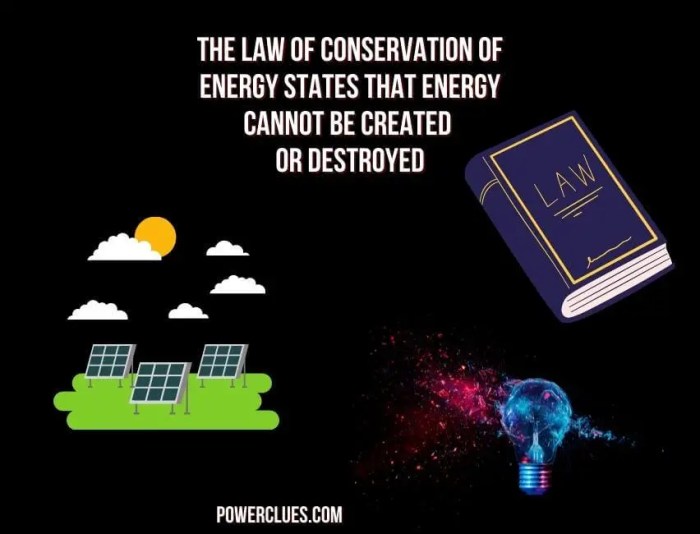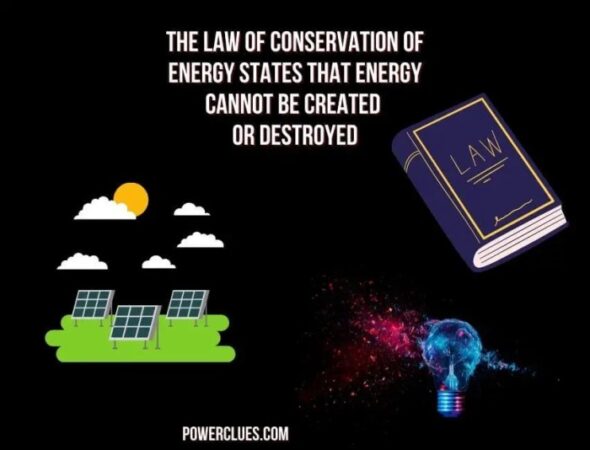
What does the law of energy conservation state? This fundamental principle, a cornerstone of physics, dictates that energy cannot be created or destroyed, only transformed from one form to another. Imagine a swinging pendulum, its energy constantly shifting between potential energy at its highest point and kinetic energy at its lowest. This principle, discovered and developed over centuries, governs everything from the movement of planets to the chemical reactions within our bodies.
The law of energy conservation has profound implications for our understanding of the universe. It helps us predict and explain countless phenomena, from the efficiency of machines to the intricate workings of ecosystems. This principle, while seemingly simple, is incredibly powerful and forms the basis for many scientific and technological advancements.
Key Concepts and Terminology

The law of conservation of energy is a fundamental principle in physics that governs how energy is transformed and transferred within a system. Understanding the key concepts and terminology associated with this law is essential for comprehending its implications and applications in various scientific disciplines.
Definition of Energy
Energy, in the context of the law of conservation, refers to the capacity to do work. Work, in physics, is defined as the force applied over a distance. Therefore, energy represents the potential to cause changes or perform actions. It is a fundamental property of all matter and exists in various forms, each associated with a different type of change or action.
Potential and Kinetic Energy
Potential energy is stored energy that an object possesses due to its position or state. For instance, a book held above the ground has potential energy due to its height. This energy is released as kinetic energy when the book is dropped, causing it to fall.
Kinetic energy, on the other hand, is the energy of motion. It is directly proportional to the mass and the square of the velocity of an object. The faster an object moves, the greater its kinetic energy.
Forms of Energy
Energy exists in various forms, each representing a specific type of change or action. The most common forms of energy include:
- Mechanical Energy: This form of energy is associated with the motion and position of objects. It is the sum of potential and kinetic energy. For example, a moving car possesses mechanical energy due to its kinetic energy and potential energy due to its position relative to the ground.
- Thermal Energy: This form of energy is related to the internal energy of a system due to the random motion of its particles. It is often referred to as heat energy and is associated with temperature changes. For example, boiling water has high thermal energy compared to ice.
- Chemical Energy: This form of energy is stored within the bonds of molecules. When chemical bonds are broken or formed, energy is released or absorbed, respectively. For example, burning wood releases chemical energy in the form of heat and light.
- Electrical Energy: This form of energy is associated with the flow of electric charges. It is used to power various devices and systems. For example, a battery stores electrical energy that can be used to power a flashlight.
- Nuclear Energy: This form of energy is stored within the nucleus of an atom. It is released through nuclear reactions such as fission and fusion. For example, nuclear power plants use nuclear fission to generate electricity.
- Radiant Energy: This form of energy is transmitted through electromagnetic waves, such as light and heat. For example, the sun emits radiant energy that warms the Earth.
The Law in Action: What Does The Law Of Energy Conservation State

The law of energy conservation is not just a theoretical concept; it plays a crucial role in understanding and predicting how energy behaves in the real world. This principle manifests in numerous everyday occurrences and forms the foundation of various scientific and technological advancements.
Real-World Examples
The law of energy conservation is evident in various everyday phenomena.
- A swinging pendulum: As a pendulum swings, its energy constantly transforms between potential and kinetic energy. At the highest point of its swing, the pendulum possesses maximum potential energy due to its height. As it swings down, this potential energy converts into kinetic energy, reaching its maximum at the lowest point of the swing. As it swings back up, the process reverses, with kinetic energy converting back into potential energy. The total energy remains constant throughout the swing, although its form changes.
- A bouncing ball: When a ball is dropped, it possesses potential energy due to its height. As it falls, this potential energy converts into kinetic energy. Upon impact with the ground, some energy is lost as heat and sound, but the remaining energy is transferred back into potential energy as the ball bounces back up. This cycle of energy transformation continues until the ball eventually comes to rest. The total energy of the ball remains constant throughout the process, even though some energy is lost due to friction and other factors.
- A hydroelectric power plant: Hydroelectric power plants utilize the law of energy conservation to generate electricity. Water stored at a high elevation possesses potential energy. As the water flows down, this potential energy converts into kinetic energy. This kinetic energy is then used to turn turbines, which in turn generate electricity. The total energy remains constant throughout the process, with potential energy being converted into kinetic energy and then into electrical energy.
Simple Experiment
A simple experiment demonstrating the law of energy conservation can be conducted using a toy car and a ramp.
- Set up: Place the toy car at the top of a ramp. This gives the car potential energy due to its height.
- Release: Release the car. As the car rolls down the ramp, its potential energy converts into kinetic energy. The car will accelerate as it gains speed.
- Observation: Observe the car’s motion. The car will continue to move until it reaches the bottom of the ramp, where its kinetic energy will be at its maximum. If the ramp is frictionless, the car will continue to move at a constant speed, demonstrating the conservation of energy.
This experiment demonstrates that the total energy of the car remains constant throughout the process, even though its form changes from potential to kinetic energy.
Applications in Different Fields, What does the law of energy conservation state
The law of energy conservation has wide-ranging applications in various fields.
- Physics: The law is fundamental to understanding and predicting the behavior of physical systems. It is used to analyze and solve problems in mechanics, thermodynamics, and other areas of physics.
- Engineering: Engineers use the law of energy conservation to design and analyze various systems, including power plants, engines, and machines. For instance, in designing a power plant, engineers must ensure that the energy input is equal to the energy output, taking into account energy losses due to friction and other factors.
- Biology: In biological systems, energy conservation is essential for life processes. Organisms obtain energy from food and use it to perform various functions, such as growth, movement, and reproduction. The law of energy conservation ensures that the total energy within an organism remains constant, even though energy is constantly being transformed and used for different processes.
Implications and Limitations

The Law of Conservation of Energy has profound implications for our understanding of the universe, guiding our understanding of how energy interacts and transforms. It also presents certain limitations and exceptions, prompting further scientific inquiry.
Implications for Understanding the Universe
The Law of Conservation of Energy provides a fundamental framework for comprehending the universe. It implies that the total amount of energy in the universe remains constant, regardless of transformations. This principle underpins our understanding of:
- Energy Transformations: The law explains how energy changes forms, such as from potential energy to kinetic energy, but the total energy remains the same. This understanding is crucial for studying phenomena like photosynthesis, where light energy is converted into chemical energy stored in sugars.
- Energy Transfer: The law governs how energy is transferred between objects and systems. This applies to everyday processes like heat transfer or the movement of objects, and also to larger-scale cosmic events like the transfer of energy from the Sun to Earth.
- The Origin and Evolution of the Universe: The law plays a key role in cosmological models, suggesting that the total energy of the universe has remained constant since the Big Bang. This implies that the universe’s expansion does not violate the law of energy conservation.
Limitations and Exceptions
While the Law of Conservation of Energy is a fundamental principle, it has certain limitations and exceptions:
- Open Systems: The law applies strictly to closed systems, where no energy enters or leaves. In open systems, like a car engine, energy can be exchanged with the environment, so the total energy within the system may change.
- Mass-Energy Equivalence: Einstein’s theory of relativity introduced the concept of mass-energy equivalence (E=mc²), demonstrating that mass can be converted into energy and vice versa. This suggests that the law of energy conservation might need to be extended to include mass as a form of energy.
- Dark Energy: The expansion of the universe is accelerating, which suggests the existence of a mysterious force called dark energy. This force might be a form of energy that does not interact with matter in the same way as other known forms of energy, posing a challenge to our understanding of energy conservation in the universe.
Energy Efficiency
The Law of Conservation of Energy is directly related to the concept of energy efficiency. Energy efficiency focuses on minimizing energy waste during transformations and transfers.
“Energy efficiency is the use of less energy services to achieve the same level of output.” – U.S. Department of Energy
- Reducing Energy Loss: The law emphasizes that energy cannot be created or destroyed, but it can be lost during transformations. Energy efficiency aims to minimize these losses, for example, by using insulation to reduce heat loss in buildings or by improving the efficiency of engines to reduce energy wasted as heat.
- Sustainable Energy Practices: Energy efficiency is crucial for promoting sustainable energy practices. By using less energy, we can reduce our reliance on fossil fuels, minimize environmental impact, and conserve natural resources.
Epilogue
The law of energy conservation is a testament to the interconnectedness of our universe. It reminds us that while energy can change forms, its total amount remains constant. This understanding has revolutionized our approach to energy efficiency, prompting us to explore ways to minimize energy waste and maximize its utilization. As we delve deeper into the intricacies of energy transformations, we continue to unravel the secrets of the universe and unlock new possibilities for a sustainable future.
Frequently Asked Questions
What are some real-world examples of the law of energy conservation?
Examples include a bouncing ball (potential energy converting to kinetic energy and back), a hydroelectric dam (water’s potential energy transformed into electrical energy), and a car engine (chemical energy in fuel converted to mechanical energy for motion).
Does the law of energy conservation apply to all types of energy?
Yes, it applies to all forms of energy, including mechanical, thermal, chemical, electrical, and nuclear energy. The total amount of energy remains constant, even as it transforms between these forms.
Can energy be destroyed?
No, energy cannot be destroyed according to the law of conservation. It can only be transformed from one form to another. For example, burning wood transforms its chemical energy into heat and light.





